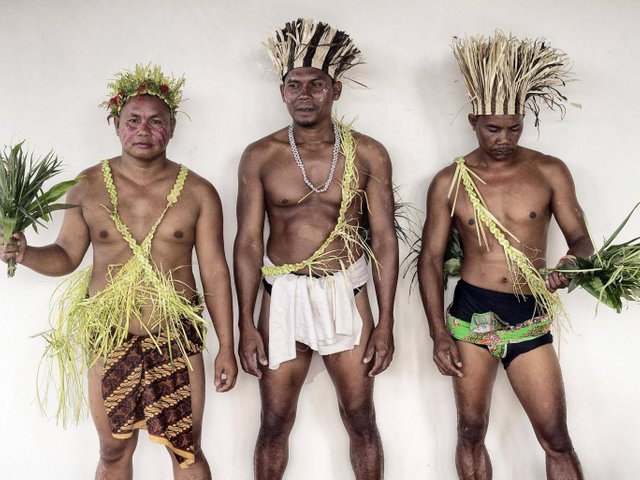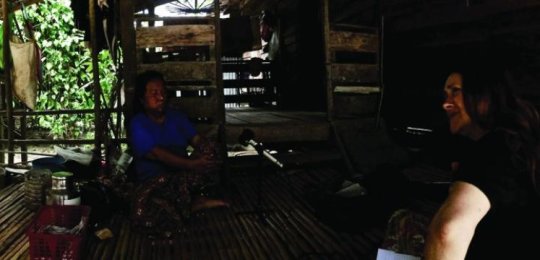HUNTER-GATHERER people in MALAYSIA have ‘SPECIAL’ SENSE OF SMELL, says study
Cell Press
Summary:
When it comes to naming colors, most people do so with ease. But, for odors, it's much harder to find the words. One notable exception to this rule is found among the Jahai people, hunter-gatherers living in the Malay Peninsula. For them, odors are just as easy to name as colors. Now a new study suggests that the Jahai's special way with smell is related to their hunting and gathering lifestyle.
Scientists use languages of indigenous groups to understand their sensory perception of the world

Members of the hunter-gatherer Jahai people, such as the man pictured in the center, appear to be more in tune with their sense of smell
Hunter-gatherers who live off the land in the forests of Malaysia are far more in tune with their sense of smell than less mobile peoples, a new study has found.
Research exploring differences between the languages used by the indigenous peoples showed they used them as a window into their sensory worlds.
The results suggest the reduced importance of smelling – known as “olfaction” – is a recent consequence of humanity becoming more settled.
READ MORE
Indigenous advocates call on UN to make cultural appropriation illegal
“Hunter-gatherers’ olfaction is superior, while settled peoples’ olfactory cognition is diminished,” said Professor Asifa Majid of Radboud University, who co-authored the study which is published in the journal Current Biology.
The work builds on a previous study that found the Jahai people of Malaysia have an unusually complex understanding of smells, as demonstrated by the number of words they have for a variety of odours.
“There has been a long-standing consensus that ‘smell is the mute sense, the one without words,’ and decades of research with English-speaking participants seemed to confirm this,” said Professor Majid, who specialises in language research.
“But, the Jahai of the Malay Peninsula are much better at naming odours than their English-speaking peers. This, of course, raises the question of where this difference originates.”
Professor Majid and her collaborator Dr Nicole Kruspe of Sweden's Lund University decided to study two other indigenous groups from the Malay Peninsula, the Semaq Beri and the Semelai.
You do not have access to view this Atom.
The Semelai are horticulturalists and rice farmers, while the Semaq Beri – like the Jahai – are hunter gatherers.
While they live in similar environments, and speak fairly similar languages, the researchers wanted to find out if the different lifestyles of these indigenous groups had an impact on their understanding of smells.
The researchers tested the colour- and odour-naming abilities of 20 Semaq Beri and 21 Semelai people.
Like the Jahai, the hunter-gatherer Semaq Beri were able to name smells with ease in the same way they named colours, whereas the non-hunter-gatherer Semelai struggled to name smells.
These findings are supported by cultural observations of the Semaq Beri, who consider odour to be so important that social spaces are carefully managed to avoid inappropriate mixing of individuals’ personal odours.
If a brother and sister sit too close together, for example, it is considered incest due to the combination of odours.
Professor Majid and Dr Kruspe these findings confirmed that a hunter-gatherer lifestyle brings with it an increased sensory ability, contradicting the idea that the structure of the brain is alone in determining sense of smell.
“For the hunter-gatherer Semaq Beri, odour naming was as easy as colour naming, suggesting that hunter-gatherer olfactory cognition is special,” the scientists wrote.
The scientists now want to establish whether this ability is found universally in hunter-gatherer populations around the world, and whether there are any genetic differences between different groups determining sense of smell.

This photograph shows a Semelai speaker with Nicole Kruspe discussing odor.
When it comes to naming colors, most people do so with ease. But, for odors, it's much harder to find the words. One notable exception to this rule is found among the Jahai people, a group of hunter-gatherers living in the Malay Peninsula. An earlier study showed that, for them, odors are just as easy to name as colors. Now a new study reported in Current Biology on January 18 suggests that the Jahai's special way with smell is related to their hunting and gathering lifestyle.
"There has been a long-standing consensus that 'smell is the mute sense, the one without words,' and decades of research with English-speaking participants seemed to confirm this," says Asifa Majid of Radboud University in the Netherlands. "But, the Jahai of the Malay Peninsula are much better at naming odors than their English-speaking peers. This, of course, raises the question of where this difference originates."
To find out whether it was the Jahai who have an unusually keen ability with odors or whether English speakers are simply lacking, Majid and Nicole Kruspe at Lund University in Sweden looked to two related, but previously unstudied, groups of people in the tropical rainforest of the Malay Peninsula: the hunter-gatherer Semaq Beri and the non-hunter-gatherer Semelai. The Semelai are traditionally horticulturalists, combining shifting rice cultivation with the collection of forest products for trade.
The Semaq Beri and Semelai not only live in a similar environment; they also speak closely related languages. The question was: how were they at naming odors?
"If ease of olfactory naming is related to cultural practices, then we would expect the Semaq Beri to behave like the Jahai and name odors as easily as they do colors, whereas the Semelai should pattern differently," the researchers wrote. And, that's exactly what they found.
Majid and Kruspe tested the color- and odor-naming abilities of 20 Semaq Beri and 21 Semelai people. Sixteen odors were used: orange, leather, cinnamon, peppermint, banana, lemon, licorice, turpentine, garlic, coffee, apple, clove, pineapple, rose, anise, and fish. For the color task, study participants saw 80 Munsell color chips, sampling 20 equally spaced hues at four degrees of brightness. Kruspe tested participants in their native language by simply asking, "What smell is this?" or "What color is this?"
The results were clear. The hunter-gatherer Semaq Beri performed on those tests just like the hunter-gatherer Jahai, naming odors and colors with equal ease. The non-hunter-gatherer Semelai, on the other hand, performed like English speakers. For them, odors were difficult to name.
The results suggest that the downgrading in importance of smells relative to other sensory inputs is a recent consequence of cultural adaption, the researchers say. "Hunter-gatherers' olfaction is superior, while settled peoples' olfactory cognition is diminished," Majid says.
They say the findings challenge the notion that differences in neuroarchitecture alone underlie differences in olfaction, suggesting instead that cultural variation may play a more prominent role. They also raise a number of interesting questions: "Do hunter-gatherers in other parts of the world also show the same boost to olfactory naming?" Majid asks. "Are other aspects of olfactory cognition also superior in hunter-gatherers," for example, the ability to differentiate one odor from another? "Finally, how do these cultural differences interact with the biological infrastructure for smell?" She says it will be important to learn whether these groups of people show underlying genetic differences related to the sense of smell.